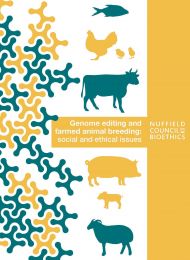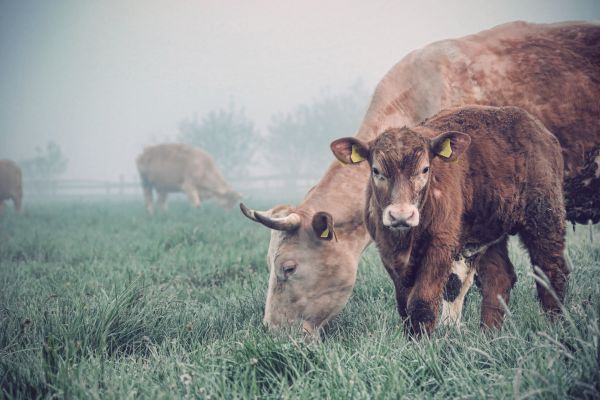Genome editing and farmed animal breeding: social and ethical issues
Report
Published 01/12/2021

New breeding technologies
See chapter 4 of the full report
Various applications of genome editing have been proposed in a number of domesticated animals and for a range of purposes. Examples of potential applications and areas of current research include:
Disease resistance
Diseases in farmed animals can be devastating in several ways – in addition to negative impacts on animal health and welfare, they can cause catastrophic economic losses for farmers, and be harmful for human health and wellbeing, ecosystems, and the environment.
Researchers have identified some specific sequences of DNA involved in disease resistance to some infectious diseases in animals. They can use this knowledge to design genome editing strategies that alter features of an animal’s physiology to make it hard for the animal to become infected with the disease.
For example, it has proved possible to make pigs that are resistant to Porcine Reproductive and Respiratory Syndrome (PRRS) – one of the most significant pig diseases in the world. This is done by knocking out a specific gene that codes for proteins involved in a receptor that allows PRRS virus to enter a pig’s cells, and cause disease.
Research has also shown the possibility of targeting a gene in cows to cause them to produce a protein in their milk that can kill the bacteria that cause mastitis, which is a prevalent infection in cattle.
However, there is a concern that genome editing for disease resistance may perpetuate, or even increase, the dense stocking of animals in industrial systems.
Alternatives to surgical intervention
Genome editing techniques are being developed to create a range of physiological changes that could replace common interventions in farming, such as horn removal, tail docking and castration.
The practice of preventing horn growth or removing horns to minimise harm to other animals and farm workers is common in livestock farming. However, many people are opposed to manual processes of dehorning, as they are painful to animals and cause them acute stress. Amongst the most advanced areas of research into genome editing applications is the production of polled (hornless) cattle. The known genetic variants associated with hornlessness do not appear to have any other adverse effects on health or productivity. Genome editing offers a promising strategy to breed hornless animals and skip the decades that may be needed to achieve this same outcome by traditional selective breeding, without the loss of other valued characteristics.
Environmental tolerance
A number of so-called ‘functional traits’ that are relevant to the specific living and environmental conditions that farmed animals live in have been targeted in breeding programmes.
For example, genome editing may provide opportunities to breed chickens with stronger bones in their legs, leading to improved mobility and fewer complications from being sedentary for long periods, or to breed farm animals with improved heat tolerance.
More than half the cattle in the world live in hot and humid environments. High temperatures can reduce their fertility and milk yield, and have a negative impact on animal welfare. Some breeding programmes in South America and Sub-Saharan Africa aim to ensure adaptation to tropical heat combined with high milk yield. An application of genome editing that has been explored is to achieve this by producing animals with lighter coloured hides, which allows them to reflect more heat and has a measurable impact on their productivity.
Production traits
Breeding for production traits is aimed towards directly increasing the value of animal products e.g. through faster maturation and increasing yield. From the evidence the working group has seen, most applications of genome editing technologies in farmed animals currently being researched are not aimed primarily at productivity gains, but this remains a possibility.
One area where technologies to improve reproduction and growth rates are being researched is in the farming of salmon. Genetic technologies have already been used to insert a DNA sequence into an Atlantic salmon from another fish, resulting in a faster growing variety that became the first genetically modified animal in the world to have been approved (in the United States) for human consumption. Researchers are exploring the possibility of achieving similar results using genome editing techniques.
Another example of the potential of genome editing is in laying chickens. Male chicks are routinely disposed of immediately after hatching since they cannot lay eggs and are of no economic value. Genome editing has been proposed as a way of adding a biological marker to allow male embryos to be identified in the egg so that they may be disposed of at the embryo stage (immediately after laying) rather than as hatchlings, thus saving incubator space and avoiding 50% of the chicken population being disposed of at birth.
Conclusions in brief
Genome editing has a range of potential applications in the breeding of farmed animals. In some cases, it is possible to see that genome editing might promote justice within our existing food and farming system, or help to address some of the challenges we have identified. However, there is also potential for genome editing to be put to uses that do not respect animals’ basic interests. We are particularly concerned about applications that might result in:
- Breeding to produce animals that can tolerate poor conditions better without apparent adverse health impacts, thereby masking the fact that they continue to live in unacceptable conditions.
- Breeding that results, over generations, in animals that have lost the physiological capacity to enjoy experiences that constitute a good life. (An example of this is the musculoskeletal problems that have resulted from historical pursuit of production traits in fast growing broiler chickens.)

Share